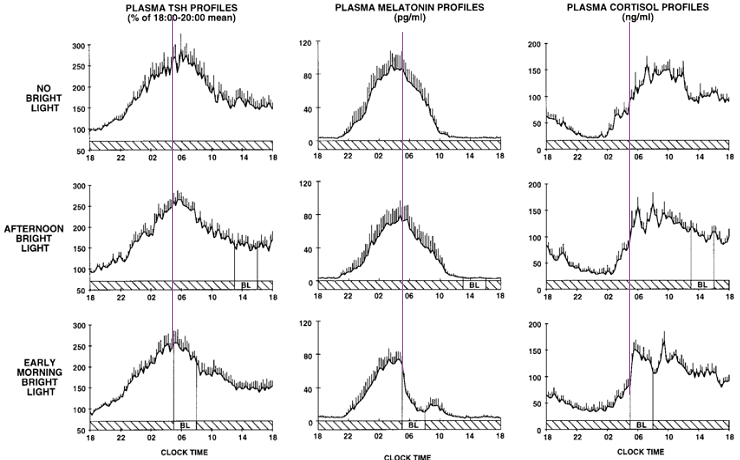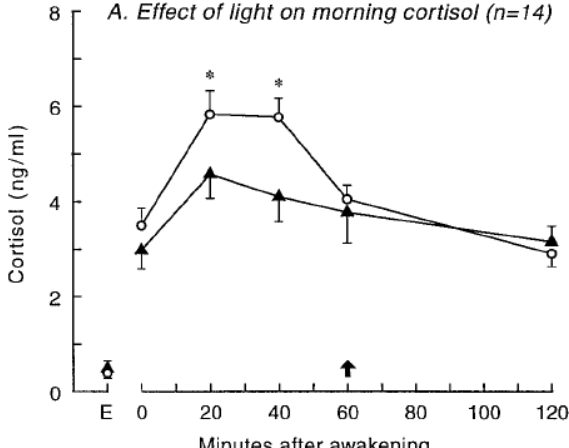Morning bright light requirement for AM cortisol melatonin response (15 minutes at 1000 - 2000 LUX should be enough, common indoor bulb lighting works but takes longer)
-
for people with low am cortisol response interested in this, (other benefits of sunlight like the red light might give benefit from longer amounts, uv for sulfated cholesterol production, activation of more things than just vit D etc)
bright light effect early is it accelerates the morning cortisol response without giving a bigger peak vs room lighting, and accelerates melatonin decrease also, vs indoor lightning (50 - 200 lux). The max effect is from a short duration (15 minutes) (extended period in bright light eventually decreases cortisol so dont need to sit in it all day) , indoor lighting is still enough for this reaction but its slower, takes a few extra hours longer to hit similar levels15 mins in 2000 lux accelerates cortisol rise & melatonin drop to max vs room lightning 150 lux which takes longer
https://www.researchgate.net/publication/12099770_Transition_from_Dim_to_Bright_Light_in_the_Morning_Induces_an_Immediate_Elevation_of_Cortisol_Levels_1 , but drops off earlier (cortisol rebounds again after stopping , here it likely drops off because of sustained time for hours in that combined with increasing to a higher lux - only need 15 minutes for the effect)
and
Light at 800 lux for 20 mins, faster increase in (salivary) cortisol in first 20 and 40 minutes which dropped off to no light cortisol by 60 mins
(this is vs no light, when its vs dim light they both rise to peak)
(in this one measuring salivary cortisol it returned to the no light elevation by 1hr, idk why it dropped off so much)
https://www.researchgate.net/publication/12811932_Light_Affects_Morning_Salivary_Cortisol_in_Humans

Sitting in artificial bright light at 10,000 LUX for hours actually lowers cortisol, by 1 hr (study started in the middle of the night so i give more weight to the others posted showing an initial boost instead of flat in the middle of the night there, unless it was the high lumens indicating needed less time)
https://www.ncbi.nlm.nih.gov/pmc/articles/PMC3686562/
According to what i read daylight with overcast clouds = ~1000 LUX , initial sunrise = 600 LUX, direct sun >30,000 lux, thin clouds 10,000 lux. indoor home rooms = 50 lux - 200 lux , computer screen maybe 50 lux at arm length https://www.reddit.com/r/askscience/comments/5kmotb/comment/dbregqw/
So daylight after waking with some clouds after sun risen a bit is probably enough for the 15 min acceleration of cortisol increase & melatonin decrease vs indoor lighting. otherwise if using a device, up to 15 minutes at 2000 lux where sitting, and maybe best to use a warm LED yellow instead of white/blue which is more damaging. (i think using red only could prevent melatonin drop).
Here 400 lux was used in mice , which took 60 minutes for the peak effect. They showed it changed gene expression in the adrenals mainly in the adrenal cortex. So lower lux = longer time , and considering the 800 lux worked in 20 minutes in humans i'd guess 5-10 minutes would be good for peak effect at 2000+ lux. (first study measured every 15 mins).
, interestingly ACTH did not have to rise for the big cortisol increase there,
light activates splanchnic nerve
https://www.cell.com/cell-metabolism/fulltext/S1550-4131(05)00269-X?_returnURL=https%3A%2F%2Flinkinghub.elsevier.com%2Fretrieve%2Fpii%2FS155041310500269X%3Fshowall%3Dtrue